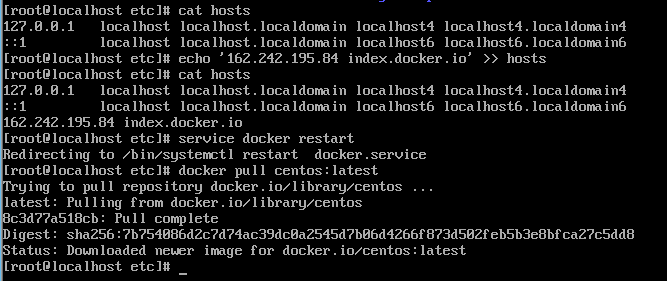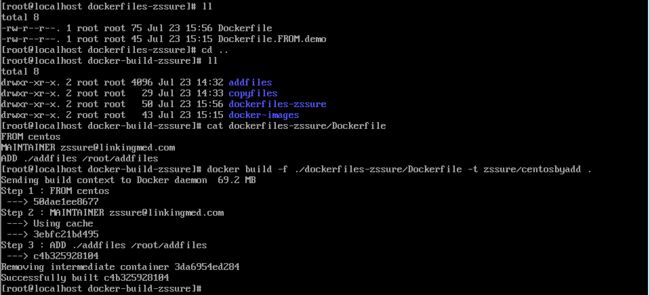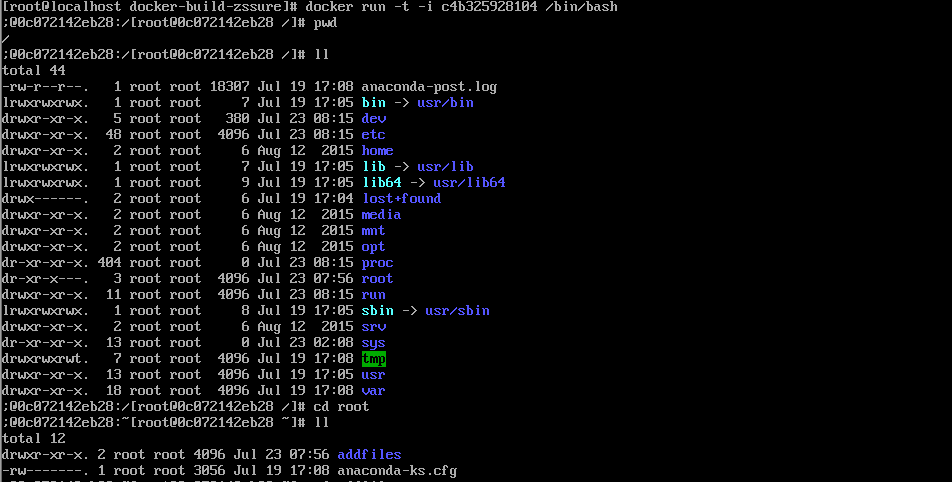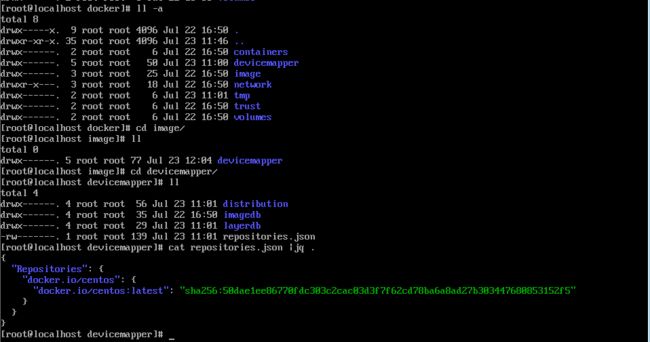DICOM:Docker实现增量发布之前期准备
背景:
为了方便整体产品的发布,希望通过docker实现增量发布。大致的思路如下:
is-there-a-way-to-add-only-changed-files-to-a-docker-image-as-a-new-layer-with。本博文对这种方式进行了尝试,与此同时简单介绍如何通过Dockerfile来创建Docker镜像。
前期准备:
- 解决centos的网络问题【can not find a valid baseurl for repo: base/7/x86_64】,使用dhclient命令
http://stackoverflow.com/questions/30424860/yum-error-centos-7-1-x86-64 - 解决下载docker官方镜像问题【Docker - dial tcp: lookup index.docker.io: no such host - Solution】,解决方案:https://linuxconfig.org/docker-dial-tcp-lookup-index-docker-io-no-such-host-fix

- centos命令行中解析json串。【How to parse JSON string via command line on Linux】,使用一个开源库,详情参考:http://xmodulo.com/how-to-parse-json-string-via-command-line-on-linux.html
【备注】:建议在windows下先下载jq库,然后再使用pscp等工具上传到linux中,我在多款linux系统下尝试使用wget直接下载,速度卡的要死。
docker镜像和容器再学习:
1. docker image
官方的解释:
- 镜像:An image is a filesystem and parameters to use at runtime. It doesn’t have state and never changes.
- 容器:A container is a running instance of an image.
- 引擎:When you ran the command, Docker Engine:
(1)checked to see if you had the hello-world software image;
(2)downloaded the image from the Docker Hub (more about the hub later);
(3)loaded the image into the container and “ran” it
我们之所以使用docker,就如同他的logo中的集装箱一样:通过docker镜像来创建和分发软件,即
Docker Engine lets people (or companies) create and share software through Docker images. Using Docker Engine, you don’t have to worry about whether your computer can run the software in a Docker image — a Docker container can always run it.
2. docker image 在本地
之前博文中专门介绍过通过 Docker来发布C-STORE服务、 Docker实现DICOM服务虚拟化,以及详细介绍过 Docker的数据卷, 其实当我们安装完Docker服务后(Docker主要包括Server、Engine、Client三大模块,后续博文会详细介绍),会跟其他软件一样,在本地生成很多目录结构,对于AUFS文件系统的本地结构可以仔细阅读博文 Where are Docker images stored?,但是由于AUFS一直没有纳入Linux内核,所以Docker会支持多种文件系统,我本地centos系统支持的是devicemapper文件系统,该文件系统在本地的存储结构如下(详细介绍可以阅读博文 Docker Supported Filesystems):
这里就不详细介绍每个目录、每个文件的含义了,后续有时间再补充。
Dockerfile创建docker镜像
docekr可以通过读取Dockerfile中的指令来自动创建镜像。下面简单介绍一下如何使用Dockerfile创建自己的镜像(关于Dockerfile的详细说明,参见官方文档 Dockerfile Reference)
本地的目录存档结构如下(【备注】:在本地如何有规律的归档各类文件是一种良好的习惯,提高效率的同时能够减少错误的发生,建议大家形成自己的习惯):

其中addfiles文件夹下存档的是一组dcm医学图像,用于测试后续Dockerfile中的ADD指令;copyfiles文件夹下存档的是一组放疗dicom-rt数据,用于测试后续Dockerfile中的COPY指令。详情见下文对应章节。
1. FROM指令
FROM指令是所有Dockerfile的第一条,目的是设置基础镜像来源,可以是远程仓库也可以是本地。FROM指令有三种格式,如下:
FROM <image> #只给出基础镜像名称
FROM <image>:<tag>#给出制定的tag标签
FROM <image>@<digest>如果镜像在本地存在会优先使用本地镜像,如果不存在需要从官方仓库中pull下来。
我本地已经将centos:latest最新镜像拉了下来,所以对Dockerfile的build会很迅速,我本地的Dockerfile内容如下:
FROM centos #默认tag=latest,即我本地的centos镜像
MAINTAINER [email protected]运行过程如下:

此时docker images查看本地镜像,结果如下:

2. ADD指令
有些时候使用docker来发布服务或软件时,需要将本地的项目拷贝到docker镜像中,ADD指令就是完成这个工作的。
例如我本地的目录结构如下

现在希望将上文提到的addfiles目录下的医学影像文件拷贝到镜像中,新的Dockerfile如下:
在Dockerfile当前目录运行,竟然出现了错误:Forbidden path outside of the build context: ../addfiles ()

出现该错误的原因是因为跟docker的build context有关,上述docker build指令会将路径作为build context,然而../addfiles并不包含在上述build context之内。所以两种解决方案:
1. 将addfiles目录拷贝到Dockerfile所在的目录
2. 返回到上一级运行docker build,(详情参考How to include files outside of Docker’s build context?)
具体结果如下:

【备注】:注意此时需要修改之前的Dockerfile,将ADD ../addfiles /root/addfiles指令改成ADD ./addfiles /root/addfiles
此刻可以看到本地多了一个镜像:

虽然从上图镜像的大小我们可以推断出结果应该是成功的,但是还是使用docker run命令行启动一个容器进入该镜像确认一下是否已经将addfiles添加成功:

由上图所示已经成功。
3. COPY指令
COPY指令与ADD指令类似,同样可以将本地文件拷贝到镜像内,目前我了解的唯一区别是ADD可以添加src为URL的源数据到镜像,而COPY只能是本地数据。
本地运行测试结果如下:

同样进入到容器内部查看一下:
结果完全正确。
具体示例:
这里节选一个博文 《Getting Started with Docker: Simplifying Devops》中的示例,大家可以去原文浏览详情。
博文中用示例给出使用docker发布web服务的大致流程如下:
1. 本地编写服务代码
import java.io.IOException;
import java.io.OutputStream;
import java.net.InetSocketAddress;
import com.sun.net.httpserver.HttpExchange;
import com.sun.net.httpserver.HttpHandler;
import com.sun.net.httpserver.HttpServer;
public class PingPong {
public static void main(String[] args) throws Exception {
HttpServer server = HttpServer.create(new InetSocketAddress(8080), 0);
server.createContext("/ping", new MyHandler());
server.setExecutor(null);
server.start();
}
static class MyHandler implements HttpHandler {
@Override
public void handle(HttpExchange t) throws IOException {
String response = "pong\n";
t.sendResponseHeaders(200, response.length());
OutputStream os = t.getResponseBody();
os.write(response.getBytes());
os.close();
}
}
}2. 使用Dockerfile创建docker镜像
Dockerfile内容如下:
FROM java:8
COPY PingPong.java /
RUN javac PingPong.java
EXPOSE 8080
ENTRYPOINT ["java"]
CMD ["PingPong"]使用Dockerfile创建镜像指令如下:
docker build -t toptal/pingpong .3. 启动发布的服务
docker run -d -p 8080:8080 toptal/pingpong4. 测试服务运行
curl http://localhost:8080/ping总结:
博文在给出上述真实示例之前,详细介绍了Dockfile中的ADD和COPY指令,因为这两个是使用docker来发布应用中必要的关键步骤。
从ADD和COPY两次创建本地镜像的实际运行状态中可以看出,使用Dockerfile构建新的镜像与我们手动启动容器,运行相关指令,再commit容器到镜像是一样的。如下图所示:
这说明Dcokerfile中的上述指令MAINTAINER、ADD、COPY都会在基础影像Base Image(即FROM指向)之上创先新的layer并commit提交为新的镜像文件,使得修改固化存储在本地。即每次发布服务时,通过更新Dockerfile文件,将本地有所变动的文件通过ADD(或者COPY)指令添加到新的layer层并生成新的镜像,从而实现自动化&增量发布的目的。
作者:[email protected]
时间:2016-07-24
